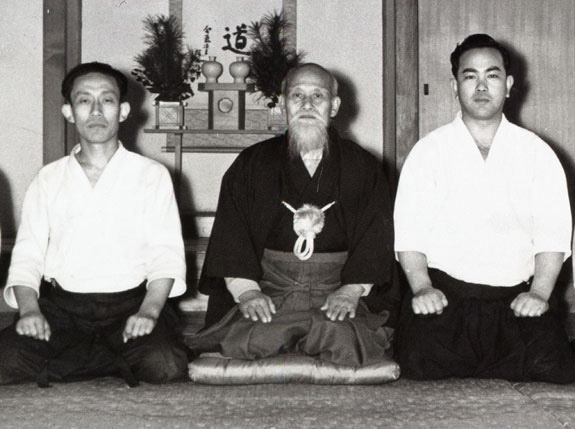 Kisshomaru Ueshiba – Morihei Ueshiba – Koichi Tohei
Kisshomaru Ueshiba – Morihei Ueshiba – Koichi Tohei
What does all of this mean? It means that the common view of the spread of aikido following the war taking place under the direct tutelage of the Founder is fundamentally in error. Tohei and the present Doshu (*Kisshomaru Ueshiba) deserve the lion’s share of the credit, not the Founder. It means further that O-Sensei Morihei Ueshiba was not seriously involved in the instruction or administration of aikido in the postwar years. He was already long retired and very focused on his personal training, spiritual development, travel and social activities.
—“Is O-Sensei Really the Father of Modern Aikido?”, by Stanley Pranin
The quote above comes from an article written by Stanley Pranin that was originally published in Aikido Journal #109 in 1996. Long time readers of Stanley Pranin are probably familiar with this line of thought, which has been supported by a cornucopia of material published in both Aikido Journal and the older Aiki News.
What follows is part 1 of an essay by Mark Murray. It is a further summation of some of the important issues surrounding the now clear divergence between the Aikido of Morihei Ueshiba O-Sensei and the Aikido of his son, Ni-Dai Doshu Kisshomaru Ueshiba.
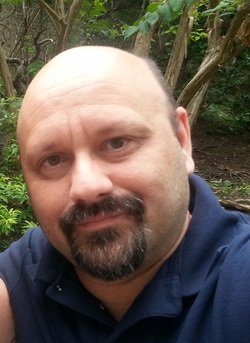
Mark is an “IT Specialist by trade and a writer by choice” (check out the Mark Murray Books website, and the Mark Murray author page on Amazon), but when he’s not doing either of those things he is usually training in the martial arts, and that is the context in which most of us are probably familiar with him.
In 2006 he was one of the first Aikido people to post a detailed public review (which originally appeared on AikiWeb) of his meeting with Dan Harden, and this was an important step in the process that eventually brought Dan to teach publicly:
Work sent me to Boston for a few days. Before I left for Boston, I contacted Dan Harden and asked if he’d meet me. I said I’d like to start learning the internal stuff. Once in Boston, I met Dan at my hotel after work one day and we walked over to the Commons.
I ended up learning a lot of things. One is that Dan is a great guy. Working out with him for the short time I had was a pleasure. I went back and forth from, “Okay how did you do that” to laughing. Most of the time I forgot I was even standing in the Boston Commons.
Two is that I just couldn’t push him over. And let me tell — that was a very disconcerting feeling. I tried pushing with both hands on his chest, tried pulling him sideways using one of his arms, and then placing a hand on the side of his head and pushing. He just stood there relaxed. I don’t know how to explain some of what I felt there. Part of it was just like pushing and nothing was budging. Almost like putting your hand on a wall, leaning into it, pushing, and it’s just there not moving, but not nearly as hard or unyielding as a wall’s surface. And parts of it I could feel that I’d lost my own balance as I started to push. In those instances, I was pushing and Dan was moving his center in such a way that he knew where I was losing my balance or what foot held most of my weight.
It was an eye opening display of some of what he can do. I say some because I also got to feel a small portion of the power he can generate. Another example of this relaxed power was that he held out both hands and asked me to throw him in a judo type throw. I grabbed both arms and that was as far as I got. There were no openings. I never got to the tsukuri, or fit, because I couldn’t even get kuzushi. In fact, there was a kuzushi but it was on me. If you’ve ever seen some of these sayings, “keep weight underside”, “extend ki”, “keep one point”, well, I got to experience them first hand. Dan also showed me the “push out exercise” where I had hold of him but couldn’t step forward. Although I didn’t feel like I was overly weighted down, I still couldn’t take a step. My feet just felt rooted to the ground.
The no-inch punch was amazing. And yes, there was no distance but the force was definitely there. I wouldn’t say it felt exactly like a punch, which is more of a percussive feel. No, this was more like a ball of energy/power hitting me and shockwaves vibrating out from where it entered my body. Next thing I know, I’m picking myself up off the ground a few feet away.
All the while, Dan is explaining how all of it is done. He was open and willing to share information on what he was doing and how it was done. He showed me some exercises to do and I tried some of them. Try is a good word. It’ll take some time doing them, especially the hanmi. LOL. But in the short time I was there, I will say that they definitely helped.
The stuff Dan is doing is good stuff. I wish I’d been able to visit his dojo and meet everyone else, but I’m hoping that my next visit, I’ll be able to do that.
———————————–
Update (December 1, 2015): I’d like to comment on the relevance of including Mark’s review of his meeting with Dan Harden, since the context seems confusing to some people.
For those who have followed the process, much of the material in this article developed over the course of discussions (and arguments) on AikiWeb and other internet discussion forums. Many of those discussions (and arguments) were centered around Dan Harden’s theories, and his participation contributed greatly to the evolution of the conversation.
As Mark recounts his experience he states “If you’ve ever seen some of these sayings, ‘keep weight underside’, ‘extend ki’, ‘keep one point’, well, I got to experience them first hand.”. To me, this is a telling statement, and symptomatic of the two legacies that Mark goes on to describe in the main body of this article – a student of modern Aikido being astonished when encountering an actual manifestation of skills so often discussed, but so rarely displayed.
Is what Dan Harden doing relevant to Aikido? Well, part of that will depend upon how you’re defining Aikido, but here’s what a direct student of Morihei Ueshiba had to say upon meeting Dan, and some discussion of what that might mean.
Now, some people may think that the point of this article and the reference above is to say that none of Morihei Ueshiba’s students understood anything at all or were able to grasp any part of his transmission, but this is absolutely not the case. I have discussed this issue in previous articles, but I will state again here that every direct student of the Founder that I’ve met (and I’ve met quite a few) seems to have gotten something from the Founder – some a little, and some a lot. The caveat being they also had trouble explaining and transmitting whatever it was that they did get from their time with him – there is a more detailed discussion of this problem in the article “Morihei Ueshiba – Profiles of the Founder“.
— Chris Li
———————————–
And now…on to Mark Murray’s essay – “The Ueshiba Legacy”.
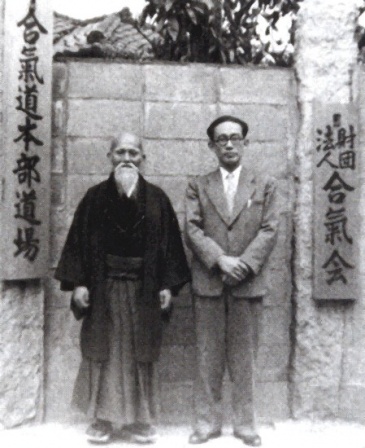 Father and Son in front of Aikikai Hombu Dojo
Father and Son in front of Aikikai Hombu Dojo
Aikido Founder Morihei Ueshiba and Ni-Dai Doshu Kisshomaru Ueshiba
The Ueshiba Legacy – Part 1
by Mark Murray
There are two Ueshiba Legacies. The legacy of Morihei Ueshiba and the legacy of Kisshomaru Ueshiba. The two are completely different. Their paths rarely cross, with only a smattering of commonalities.
A: The Words
From the translation on the Sangenkai website, “Aikido is the way of harmony, that is to say the living form of Ichirei Shikon Sangen Hachiriki, the form of the fabric of the universe, specifically the form of the High Plain of Heaven.” (1) Ueshiba would talk about this often. He explained Hachiriki as “The 8 powers are opposing forces: Movement – Stillness, Melting – Congealing, Pulling – Loosening, Combining – Splitting / 9-1, 8-2, 7-3, 6-4” (1). Note that the 8 powers are 4 pairs of opposites.
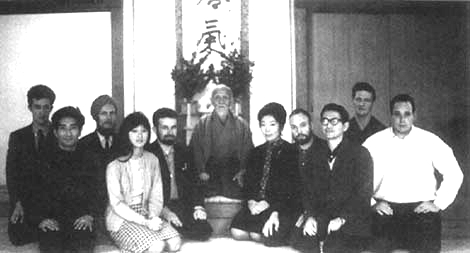 Aikido Founder Morihei Ueshiba and a group of foreign students
Aikido Founder Morihei Ueshiba and a group of foreign students
Left to right: Alan Ruddock, Henry Kono, Per Winter, Joanne Willard,
Joe Deisher, O-Sensei, Joanne Shimamoto (later married to Akira Tohei),
Kenneth Cottier, Edward Yamaguchi, Norman Miles and Terry Dobson
When Henry Kono asked O-Sensei “Why can we not do what you do, Sensei?” the answer was quite simply “Because you don’t understand In and Yo.” (2) Opposing forces. One of Ueshiba’s doka (“poems of the way”) was “Manifest yo (yang) in the right hand, change the left hand to in (yin) and guide the opponent.”.
More from what Ueshiba said: “Aikido is the Way and Principle of harmonizing Heaven, Earth and Man.” Ueshiba talked about Izanami and Izanagi. He talked about The Floating Bridge of Heaven. He talked about kami, which was often written as ka (火 / fire) and mi (水 / water). Whether during the famous pre-war era or during the post-war era, Morihei Ueshiba described his aikido by using a specific spiritual ideology.
 Rinjiro Shirata at the Kobukan Dojo in 1935
Rinjiro Shirata at the Kobukan Dojo in 1935
Rinjiro Shirata, another pre-war student, gives some more details about Ueshiba’s teaching style – “We never practiced techniques in any specific order. It was not a practice where we were taught. As I told you before, Ueshiba had his own training. Therefore, he practiced techniques as he wanted. That was his training. Ueshiba Sensei’s way of explaining techniques was first of all to give the names of kamisama (deities). After that, he explained the movement. He told us, ‘Aikido originally didn’t have any form’. The movements of the body in response to one’s state of mind became the techniques.”. (3)
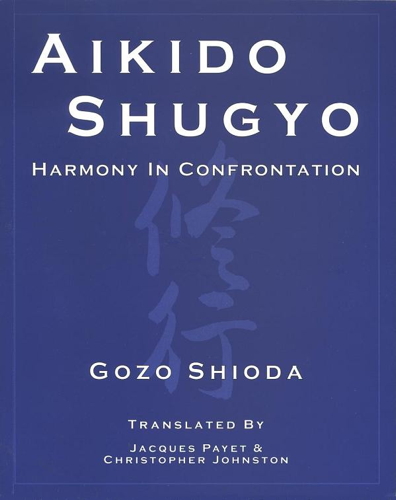 “Aikido Shugyo“, by Gozo Shioda
“Aikido Shugyo“, by Gozo Shioda
Shioda’s thoughts about Ueshiba: “As mentioned earlier, at the Ueshiba Dojo in the old days we didn’t explicitly have any pre-set forms. The only thing the students could do was copy the techniques that Sensei performed on their own. In terms of instruction, the only thing we were told was to ‘become one with heaven and earth’.”. (4)
From an article in Black Belt magazine about training in post-war: “The first class is usually taken up mostly with discussions about God and nature – Uyeshiba doing the talking and the uchideshi listening. It is in this hour that the young uchideshi is exposed to Zen philosophy and the deeper meanings of aikido – its nonviolent and defensive perfection and understanding
If this all sounds rather remote and difficult to grasp for a Western reader, he may be interested to know that the young Japanese uchideshi often feels the same way. The 83-year-old Uyeshiba many times speaks about highly abstract topics, lapsing usually into ancient Japanese phraseology, so that his listeners often find it difficult to follow him.”. (5)
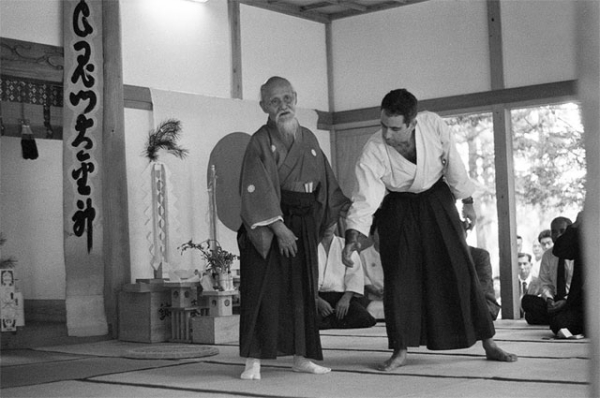 Morihei Ueshiba with Robert Frager
Morihei Ueshiba with Robert Frager
Robert Frager also talks about his training and Ueshiba’s incomprehensible speeches – “I understood very little of his talks. Osensei used a great many esoteric Shinto terms, and he spoke with a strong regional accent. His teachings were pitched at a philosophical, mystical level, far above my beginner’s concerns about where I had to place my hands and feet. I puzzled over statements like, ‘When you practice Aikido, you stand on the floating bridge between heaven and earth,’ and ‘Put the Shinto Goddess ‘She-who-invites’ in your left foot and the God ‘He-who-approaches’ in your right foot.’.”. (6)
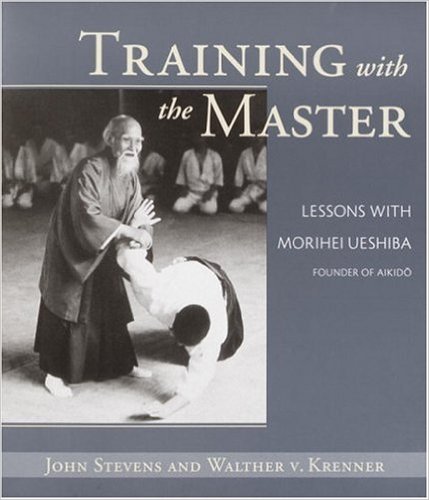 Training with the Master, by Walther Krenner and John Stevens
Training with the Master, by Walther Krenner and John Stevens
Walther Krenner notes that Ueshiba would sometimes come in and talk for a long time. (7) Kisshomaru Ueshiba also talks about his father’s baffling spiritual experiences. (8) Yoji Tomosue also found it difficult to understand Ueshiba. (9) Tamura relates that the young students didn’t understand what Ueshiba was saying. (10) There is an interesting interview with Henry Kono in an Aikido Today magazine:
ATM: When you had conversations like these with O’sensei, what would you talk about?
HK: Well, I would usually ask him why the rest of us couldn’t do what he could. There were many other teachers, all doing aikido. But he was doing it differently – doing something differently. His movement was so clean!
ATM: How would O’sensei answer your questions about what he was doing?
HK: He would say that I didn’t understand yin and yang [in and yo]. So, now I’ve made it my life work to study yin and yang. That’s what O’sensei told me to do. (11)
Looking back to the pre-war era, one would think that Ueshiba would have been much easier to understand. However we have to remember that Ueshiba had about ten years before the Kobukan dojo opened to refine his spiritual ideology. Takako Kunigoshi states that there wasn’t anyone who could understand Ueshiba. (12) Shirata remembers Ueshiba giving the names of kamisama as explanations. (13) Mochizuki considered Ueshiba a “primitive genius who couldn’t explain anything.” (14) In fact, Mochizuki goes on to say that Ueshiba wouldn’t explain but would rather say it came from God. (15) (16)
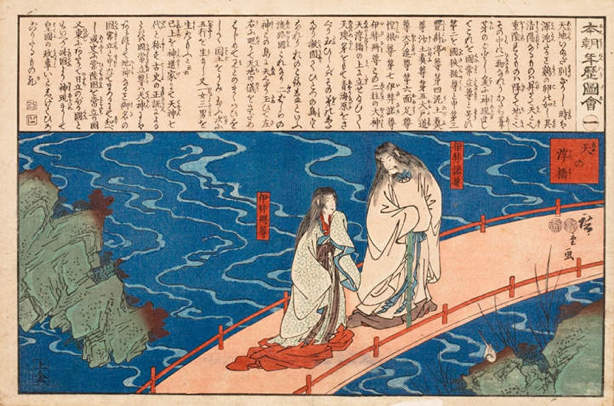 The Gods Izanagi and Izanami on the Floating Bridge of Heaven
The Gods Izanagi and Izanami on the Floating Bridge of Heaven
Ueshiba stated: “The left hand is Izanagi, the right is Izanami, in the center is Ame-no-minakanushi, this is yourself. This is standing on the Floating Bridge of Heaven and turning in a spiral. This is called Taka-ama-hara. Heaven and earth are one unit, water and fire are also one unit, all appears through Iki (breath). This is the endless appearance of the Kami. Aiki technique comes forth endlessly.” (17)
More from Ueshiba: “It is said that Aikido must first stand on the Floating Bridge of Heaven. It is said that the Floating Bridge of Heaven is the exchange of Fire and Water. Precisely in the form of a cross, it is the world of Fire and Water in harmony. In other words, it is said the this world is created through the two actions of the twin gods Takami-Musubi and Kami-Musubi winding up in a spiral on the right and winding down in a spiral on the left. Fire (“Ka”) and Water (“mi”) become “Kami”, the source of this “Kami” (Fire and Water) returns to the one, but the one becomes the source of the physical and the spiritual. “. (18)
No matter if we look at the pre-war period or the post-war one, we find that Ueshiba’s spiritual ideology hindered his students understanding of what to work on in training aiki. Hardly anyone ever really understood what Ueshiba meant by his explanations.
Regarding the worldwide version of aikido that was disseminated after Morihei Ueshiba’s death, from around 1970 on, how often has a student of aikido been frustrated to understand Izanami, Izanagi, kami, Hachiriki, or the Floating Bridge of Heaven from their instructor? How often has those terms actually come up? If they ever have (which is rare), how were they explained?
Kisshomaru Ueshiba was given control over the Tokyo dojo and he changed many things. One of those was the actual message of his father. As a brief explanation, this was after the war when Japan had lost and was in turmoil. Martial arts were mostly banned. The Tokyo dojo was in shambles. Kisshomaru picked up the pieces, put them back together, and from his experiences during the war, changed aikido’s message to something the world could embrace – which it did by millions of people.
The fact remains that the words and vision of aikido between Morihei Ueshiba and what was spread throughout the world, Modern Aikido for lack of a better term, are completely different.
(1) “Aikido and the Structure of the Universe”
(2) “Aikido Memoirs” by Alan Ruddock
(3) Aiki News Issue 062
(4) “Aikido Shugyo” by Gozo Shioda
(5) Black Belt 1966 Vol 4 No 5
(6) Yoga Journal March 1982
(7) “Training with the Master” by John Stevens
(8) Aiki News Issue 031
(9) Aiki News Issue 031
(10) Aiki News Issue 066
(11) Aikido Today Magazine; #31 Dec.93/ Jan. 94.
(12) Aiki News 047
(13) Aiki News Issue 062
(14) Black Belt 1980 Vol 18 No 4
(15) Black Belt 1980 Vol 18 No 4
(16) Black Belt 1989 Vol 27 No 8
(17) “Aikido and the Floating Bridge of Heaven”
(18) “Morihei Ueshiba and the Way of the Cross”
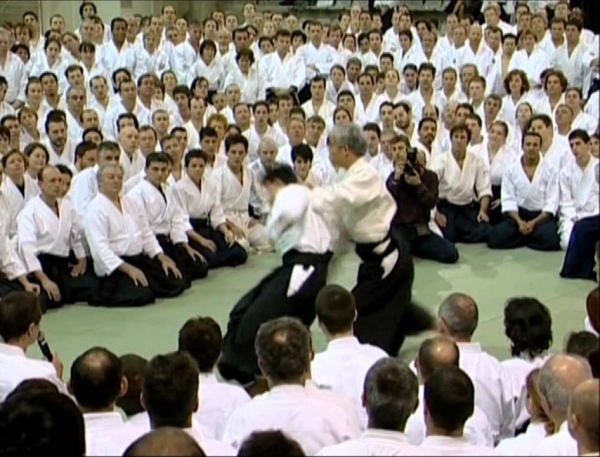 San-Dai Doshu Moriteru Ueshiba teaching 3,000 people in Paris – 2004
San-Dai Doshu Moriteru Ueshiba teaching 3,000 people in Paris – 2004
B: The Training
According to an Aikikai estimate, 1.2 million people are practicing aikido worldwide, but that probably doesn’t include non-Aikikai related schools. Still, at a minimum, millions of people are training aikido. If we focus on all those millions of aikido people taking “ukemi” for 40 to 50 years and that some of them spent quite a bit more time training with their teachers than pre-war or post-war students did with Ueshiba, then where are the people that rival Gozo Shioda or Kenji Tomiki’s abilities, let alone the skill level of Morihei Ueshiba? How many of the millions who have trained and learned the outward physical techniques of aikido for 40-50 years have replicated Ueshiba’s exploits?
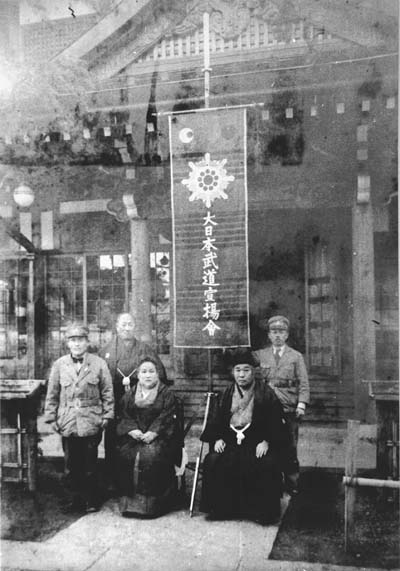 Under the Dai-Nippon Senyokai (大日本武道宣揚会) banner Morihei Ueshiba (left) with the Omoto-kyo’s Sumiko and Onisaburo Deguchi
Under the Dai-Nippon Senyokai (大日本武道宣揚会) banner Morihei Ueshiba (left) with the Omoto-kyo’s Sumiko and Onisaburo Deguchi
in 1932. Aritoshi Murashige standing back right
What happens when we look at all the people who are studying misogi-no-gyo or Omoto kyo or Zen meditation? If we focus on those people, you still have no one who has achieved Ueshiba’s abilities. How many people who focused on the spiritual only and practiced misogi exercises have replicated Ueshiba’s abilities? We can turn to one of Ueshiba’s students for an answer. Around 1952, Seiseki Abe says this about talking to Ueshiba, “How did you ever learn such a wonderful budo”, and he answered, ‘Through misogi.’ Now I had been doing misogi since 1941 and when I heard that Aikido came from misogi, suddenly ‘snap’, the two came together.”. (1)
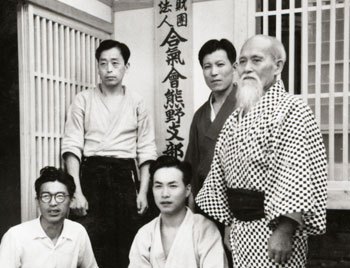 Seiseki Abe, standing far left, with Morihei Ueshiba
Seiseki Abe, standing far left, with Morihei Ueshiba
Kumano Juku, 1954
Seiseki Abe had been doing misogi for at least 10 years prior to training in aikido and wasn’t at all near Ueshiba’s skills or abilities, nor did he even see misogi and aikido as being similar. However, under Ueshiba’s tutelage, Seiseki Abe continued to grow as a martial artist. We can see from this that something that Ueshiba knew and had trained was the underlying basis for powering his misogi exercises. Other people who did not have that certain something did not grow to replicate Ueshiba’s abilities. Looking at Omoto kyo, how many people who don’t practice techniques have replicated Ueshiba’s abilities? How many Omoto kyo people who do practice techniques have replicated Ueshiba’s abilities? Yet, when we look at Ueshiba’s peers, we find that they did replicate exploits and abilities. Those peers did not practice Omoto kyo nor misogi. What they did practice was exercises for Daito ryu aiki. This aiki was the power behind Ueshiba’s misogi and not the other way around.
Now, if we look at the millions of aikido people practicing techniques day after day, year after year, decade after decade and not replicating Ueshiba’s abilities, isn’t it time to accept the truth that Morihei Ueshiba’s aikido and Modern Aikido are very different?
The focus on techniques was a modern change instilled into what became Modern Aikido for the world. Ueshiba never preached techniques. In fact, his art was formless. Students griped that they rarely saw a technique twice. When asked about techniques, Ueshiba’s reply showed the overwhelming nature of trying to learn them all. He said, “There are about 3,000 basic techniques, and each of them has 16 variations … so there are many thousands. Depending on the situation, you create new ones.” (2)
Rinjiro Shirata explained his memories of early training with Ueshiba: “We never practiced techniques in any specific order. It was not a practice where we were taught. As I told you before, Ueshiba had his own training. Therefore, he practiced techniques as he wanted. That was his training. Ueshiba Sensei’s way of explaining techniques was first of all to give the names of kamisama (deities). After that, he explained the movement. He told us, ‘Aikido originally didn’t have any form. The movements of the body in response to one’s state of mind became the techniques.’.” (3)
and
“Since Aikido is formless, we move according to how we feel.” (3)
and
“Ueshiba Sensei didn’t have techniques. He said: ‘There are no techniques. What you express each time is a technique.’.” (4)
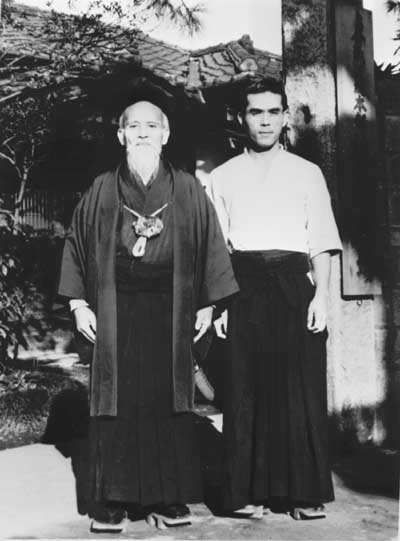 Kanshu Sunadomari with Morihei Ueshiba, around 1960
Kanshu Sunadomari with Morihei Ueshiba, around 1960
Kanshu Sunadomari remarked that if you stick to form, you only get the old style martial arts. He also talked about Ueshiba and training: “O-Sensei said, ‘Aiki is to teach the basis for the creation of budo in which techniques are born as one moves.’ So you have to understand the basis for the creation of techniques. The basis is kokyu power. There is nothing else. When you develop kokyu power, countless techniques emerge. You can’t create techniques only by doing the forms of the past.”. (5)
Shioda notes that in pre-war training, there were no pre-set forms. They had to mimic what Ueshiba did. (6) In turn, David Lynch states that Shioda developed a systemized curriculum to help new students learn better. (7) If we address the actual issue of techniques, it’s interesting to find what two main aikido instructors thought about them.
Kisshomaru Ueshiba: “It was around 1937 or 1938 that I began to practice Aikido seriously. I had already learned techniques by then. One can learn techniques in two or three years.”. (8)
Koichi Tohei: “… the physical techniques can be easily learned within a short time span, like other Martial Arts.”. (9)
Koichi Tohei: “When I visited Chicago a few months ago, four Ohioans came to study under me and I was surprised because they knew the techniques quite well. When I inquired who taught them, they said that they had learned it from my book. One person would read while the others practiced the techniques. They didn’t reveal any major faults in their movements.”. (10)
As merely a technicality, one could say that Ueshiba taught techniques. A major point of fact as shown by the various schools of aikido, Ueshiba had to have taught something or else they wouldn’t have a technique based curriculum. As a matter of actual truth, though? No, Ueshiba didn’t teach techniques. He viewed his art as formless and where his body moved, his training partner created the openings for techniques to happen. The students did the best that they could with what Ueshiba gave them. Since he wasn’t really teaching the secrets, the students mimicked the forms and trained techniques. It was the students who developed a curriculum by writing down techniques and sorting them into some type of syllabus.
In the pre-war era, there weren’t that many hours of being taught by Ueshiba but rather many hours of practice with peers and seniors. It was mentioned that pre-war students often did techniques with seniors. We can see on film how Ueshiba “taught”. Who actually learned techniques from Ueshiba in those films or did the students just mimic what they saw? Many of the students of Ueshiba complained that he wouldn’t show a technique twice. We also must consider Mochizuki complaining that Ueshiba completely pared down the Daito ryu techniques into a much small number. If techniques were Ueshiba’s focus, then why did he trim so much? Why didn’t he set some sort of curriculum? Why did he say his art was formless?
If we shift our focus to consider the post-war era when Ueshiba was in Iwama, who taught at Tokyo? When Ueshiba was traveling around, who taught at Iwama or Tokyo? How about the training schedule at Tokyo where Ueshiba only “taught” the morning class? Even then, many of the students complained he talked away most of the time. Who actually put together a jo and bokken syllabus in Iwama? Saito did.
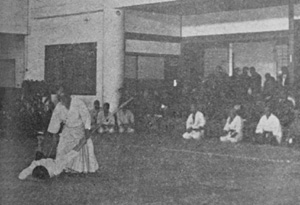 Morihei Ueshiba demonstrating at the Shinbuden Dojo
Morihei Ueshiba demonstrating at the Shinbuden Dojo
Manchurai, 1942
We can also look at another example to show that Ueshiba wasn’t focused on techniques at all but rather his vision of aikido. At a demonstration in Manchuria, Ohba, as uke, showed that Ueshiba had skills that went outside the spiritual vision. This was supposed to be a prearranged demonstration but Ohba changed his attacks. Ueshiba was called upon to handle some very realistic attacks. In fact, Shigenobu Okumura stated: “At that time I was a student and I saw this demonstration. The demonstration was as serious as any I have ever seen. I could tell that it was not a prearranged demonstration at all.” (11) Ueshiba was fumingly angry that Ohba had changed his attacks and he stayed that way until appeased by the words of Hideo Sonobe, who gave high praise. It would appear that Ueshiba’s chosen demonstration of how he viewed his art of aikido was ruined by Ohba’s very strong and unrehearsed attacks. Ueshiba had a prearranged vision of his aikido that included an emphasis on set attacks with which he allowed the kami to manifest the technique. The focus was not on techniques.
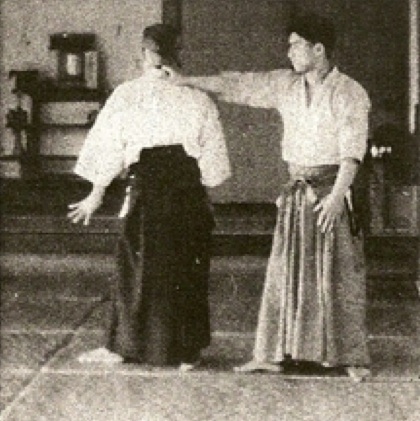 Gozo Shioda and Morihei Ueshiba
Gozo Shioda and Morihei Ueshiba
from the technical manual “Budo”, 1938
Shioda also said that Ueshiba told him, “In a real fight, Aikido is 70 percent atemi and 30 percent throwing.” (12) The specific factor here is “real fight”. We can guess that in a real encounter which isn’t preset, Ueshiba relied upon his Daito ryu training, which included atemi and aiki. Techniques were not the focus. We can see that Ueshiba definitely had the skills, but chose to only show or use certain aspects, or certain subsets, in his vision of aikido. Consider that when a student was picked as an uke by Ueshiba, if that student didn’t attack in a very specific way that Ueshiba wanted, then that student didn’t get picked as uke again. Ueshiba was very specific in demonstrating his vision of aikido. He viewed what he did as a spiritual ideology using his students as training partners rather than focusing on actually teaching his students the secret of aiki.
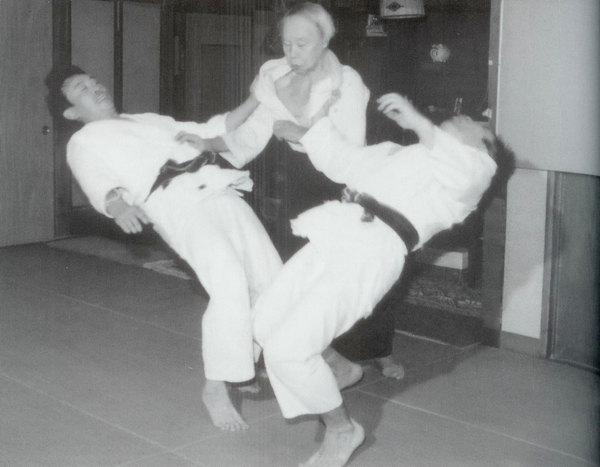 Yukiyoshi Sagawa with Masaru Takahashi and Tatsuo Kimura
Yukiyoshi Sagawa with Masaru Takahashi and Tatsuo Kimura
Speaking of aiki, if we look to Yukiyoshi Sagawa, we find that he states aiki is a body training method and it isn’t about techniques. In fact, Sagawa, Kodo Horikawa, Seigo Okamoto, and Ueshiba all said their art was formless. Not some set curriculum of techniques, but formless. Then we find that Tokimune Takeda (*Note: see “Solo Training for Kokyu-ryoku and Ki in Daito-ryu Aiki Budo“), Takuma Hisa, Kodo, Sagawa, and Ueshiba all had solo training exercises that did not get shown. Where is their focus on techniques? They did not have it.
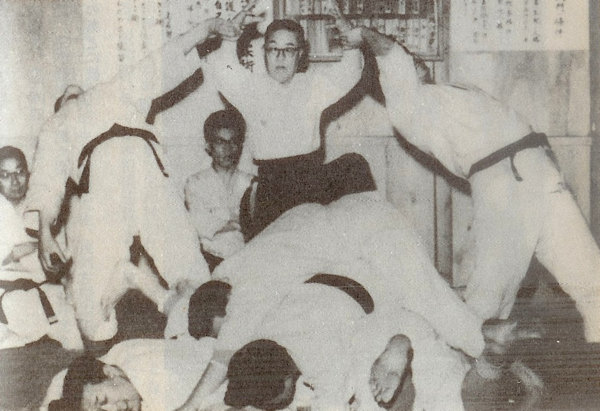 Daito-ryu Aiki-jujutsu Kodokai founder Kodo Horikawa
Daito-ryu Aiki-jujutsu Kodokai founder Kodo Horikawa
The focus on techniques is in Modern Aikido. Now that the world has practiced Modern Aikido and its techniques since, let’s say, 1960, where have people progressed? Where are the peer level people of Gozo Shioda or Rinjiro Shirata? How about those who have made it to replicate Ueshiba’s abilities? Even some of the direct students have said that they haven’t reached Ueshiba’s level. What does that say for their students?
What has Modern Aikido been doing for 50 years? Techniques. Why is it that Kisshomaru Ueshiba and Koichi Tohei stated that techniques can be learned in a short amount of time? Doesn’t 50 years of focused study on techniques with no worldwide appearance of anyone like Shioda, Shirata, or Ueshiba state something very definitive? Doesn’t that state that there are two unique visions of aikido? Morihei Ueshiba’s and Modern Aikido’s.
(1) Aiki News Issue 045
(2) Aiki News Issue 018
(3) Aiki News Issue 062
(4) Aiki News Issue 063
(5) Aiki News Issue 065
(6) “Aikido Shugyo” by Gozo Shioda
(7) Aikido Journal 103
(8) Aiki News Issue 056
(9) From Westbrook and Ratti’s “Aikido and the Dynamic Sphere“.
(10) Black Belt 1965 Vol 3 No 11.
(11) Aiki News Issue 086
(12) “Aikido Shugyo” by Gozo Shioda
Conclusion
There are two very different legacies to aikido. Kisshomaru created a worldwide vision of aikido that was accepted by millions. The world adopted the peaceful vision and the created curriculum. Some took the spiritual message as the most important part over martial viability, some took the martial viability over the spiritual, and others blended the two.
Someone who wanted a peaceful, spiritual training environment could find it. Someone who wanted a more martial environment could find it. Make no mistake, even with all the hoopla about aiki bunny hopping, there are people who have made Modern Aikido very martially viable. Ellis Amdur has an eloquent blog regarding just one example. (1)
The world embraced Modern Aikido, gave it life, gave it purpose, and created a legacy. The only unfortunate thing to it all is that the world mistakenly traced that legacy back to Morihei Ueshiba.
Morihei Ueshiba’s legacy is based upon aiki. This was the aiki that was passed down to him from Sokaku Takeda. His words were actual training explanations for developing the way of that specific aiki. And beyond those words that most couldn’t understand, he also explained aiki in very simple, direct terms … to a select few. A very specific training paradigm to change the body. Morihei Ueshiba took that aiki training, changed his body, studied Daito ryu, dabbled in other martial arts, and infused his Omoto kyo with it. A very different legacy than Modern Aikido. Ueshiba’s aikido was martially valid and stood out as unique from koryu jujutsu, judo, and other martial systems. Ueshiba’s aikido also created a visionary spiritual idealogy based entirely upon aiki but couched in Omoto kyo terms.
The world is big enough for both legacies. Different visions for different people. Modern Aikido must take a step back and start acknowledging their actual Founders – People like Kisshomaru Ueshiba, Koichi Tohei, Morihiro Saito and others. Give them the credit that is rightly due by hanging their picture on the shomen. Morihei Ueshiba should be reserved for those seeking the legacy of aiki that was passed down from Sokaku Takeda.
(1) “The Use of Weapons in Aikidō Training”
Appendix – Formlessness of the Arts
Aiki News Issue 018
“Ueshiba: There are about 3,000 basic techniques, and each of them has 16 variations … so there are many thousands. Depending on the situation, you create new ones.”
Aiki News Issue 062
“He told us, “Aikido originally didn’t have any form. The movements of the body in response to one’s state of mind became the techniques.” ” — Shirata
“Since Aikido is formless, we move according to how we feel.” — Shirata
Shirata Sensei: We never practiced techniques in any specific order. It was not a practice where we were taught. As I told you before, Ueshiba had his own training. Therefore, he practiced techniques as he wanted. That was his training. Ueshiba Sensei’s way of explaining techniques was first of all to give the names of kamisama (deities). After that, he explained the movement. He told us, “Aikido originally didn’t have any form. The movements of the body in response to one’s state of mind became the techniques.
Aiki News Issue 063
“Ueshiba Sensei didn’t have techniques. He said: “There are no techniques. What you express each time is a technique.” ” — Shirata
Aiki News Issue 065
“Sensei understood the word “takemusu” as the revelation of one of the kami. “Takemusu” is the basis for the creation of all things. Aikido represents the form which creates all things through the body. O-Sensei said, “Aiki is to teach the basis for the creation of budo in which techniques are born as one moves.” So you have to understand the basis for the creation of techniques. The basis is kokyu power. There is nothing else. When you develop kokyu power, countless techniques emerge. You can’t create techniques only by doing the forms of the past.” — Sunadomari
“If you teach form only, you end up only with an old-style martial art.” — Sunadomari
Aiki News Issue 074
Sagawa: Takeda Sensei’s teaching method was always practical. He never taught us kata (forms).
Aikido Journal 103 (Vol 22, no 2)
Interview with David Lynch
Shioda Sensei, like many other former students of O-Sensei, felt that O-Sensei’s teaching was unsystematic, and he therefore devised his own set of basic exercises that were intended to make the art easier for the average person to learn. These basic exercises (hiriki no yosei and shumatsu dosa, for instance) are not found in other dojos.
Aikido Shugyo by Gozo Shioda
As mentioned earlier, at the Ueshiba Dojo in the old days we didn’t explicitly have any pre-set forms. The only thing the students could do was copy the techniques that Sensei performed on their own. In terms of instruction, the only thing we were told was to “become one with heaven and earth.”
International Aikido Federation (IAF) Chairman Peter Goldsbury
(originally posted on AikiWeb)
There are many subjective accounts of how Morihei Ueshiba trained and what he taught, but I do not think that these accounts allow us to state categorically that this or that was how Ueshiba taught or trained. Apart from Doshu, who I think is in a special category, the Hombu instructor with whom I have discussed these issues the most is Hiroshi Tada. Like Tohei, H Tada was a student of Tempu Nakamura, but he seems to have been very careful as to what he taught in the Hombu and what he taught in his own dojo and in Italy. In other words, he seems to have accepted the idea that only certain things were to be taught or practiced in the Hombu, but also that the other things were to be practiced elsewhere. He teaches weapons in Italy, but never in the Hombu, and when I mentioned some details of a certain jo kata that I practiced in Italy to another Hombu instructor, he was very curious and wondered where Tada had learned it. Like other older Hombu instructors, Tada sets great store by solo training exercises and these seem to consist mainly of kokyu exercises of increasing sophistication and complexity. But he has never taught anything like pushing hands etc and I suspect that the occasion for seeing the results of all this kokyu training would be in basic aikido waza, like shoumen-uchi 1-kyou. This issue for me is which bit of Tada’s training comes from Nakamura and which bit from Ueshiba — and whether he could make such a distinction. Add to this Ellis Amdur’s theory of Ueshiba’s use of his students as ‘crash-test dummies’ and you also have to entertain the possibility that he showed different things to different students — and he showed this by having them take ukemi. You also have to entertain the possibility that the skills that Ueshiba possessed which could be interpreted as IP skills could be acquired by Ueshiba’s students in various ways, but not necessarily from Ueshiba himself by a direct transmission.
and
I am not sure that acceptance is the right word here. Sufferance might be more appropriate. One of the yudansha who trains with the group I look after in the Netherlands attends the workshops of Dan Harden and Minoru Akuzawa when they come to Europe. His aikido comes from another source, of course, but on one occasion a senior Hombu instructor stopped and asked him, “Why are you so strong?” The question was not meant in a negative sense at all and he was not talking about physical strength. The instructor knew exactly what he was seeing and I believe the older generation of instructors in Japan also know this. But, as you say, this knowledge is clandestine and limited to individuals. These individuals are in the Aikikai, but are dwindling in number. Yamaguchi, Tada and Arikawa used to visit our dojo regularly and I once asked an instructor why Doshu (the present Doshu, not Kisshomaru) was never invited. This was a few years ago and the answer was quite blunt: “He’s too young and does not know enough.”
I think Doshu is an active exponent of a certain interpretation of iemoto, but the great danger here is that aikido is not a koryu and does not have kata in the sense understood in a koryu. There is a sense that the waza can be seen as vehicles for the expression of creativity and this, to my mind, is what Morihei Ueshiba meant by Takemusu Aiki. He always showed waza, as did Takeda Sokaku, but seems to have presented them slightly differently to different deshi. So creativity can be understood in many ways. Unlike the present generation of Japanese martial arts exponents, Morihei Ueshiba also read the Chinese classics and was familiar with all the texts that are the foundation of Chinese internal arts. Recently I came across a scholarly work on yin-yang and its place in Chinese thought and culture. Even a quick read was enough to show that this is a complex and multi-faceted concept. We all know the question that a student asked Morihei Ueshiba and his answer, citing the knowledge of yin and yang. Ueshiba did not give any further explanation and left it to the students to grasp what he meant. The point is that he was probably familiar with the whole breadth and depth of the concept, but his students did not share this familiarity.
“Hidden in Plain Sight“, by Ellis Amdur (pp. 181-182)
“Solo training seems to be a common link among Daito-ryu practitioners and the various methods of this training develop different types of internal strength. Such training can include: a) wringing / twisting / coiling of the body to develop the connective tissue; b) methods of breathing to generate “pressure”, which builds power from the inside out; c) mental imagery and focused attention that causes subtle micro-adjustments of the nervous system that, in essence, “rewire” the body, so that it functions at increasing levels of efficiency, without unnecessary conflicts between extensor and flexor muscles, for example. Different practitioners of Daito-ryu, including Ueshiba, probably used different exercises and also probably trained in these aspects in different proportions. In this way, their abilities would have developed in different spheres.”
Published by: Christopher Li – Honolulu, HI
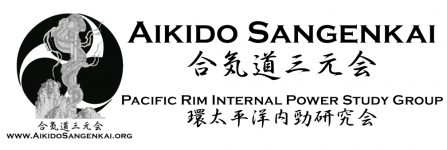
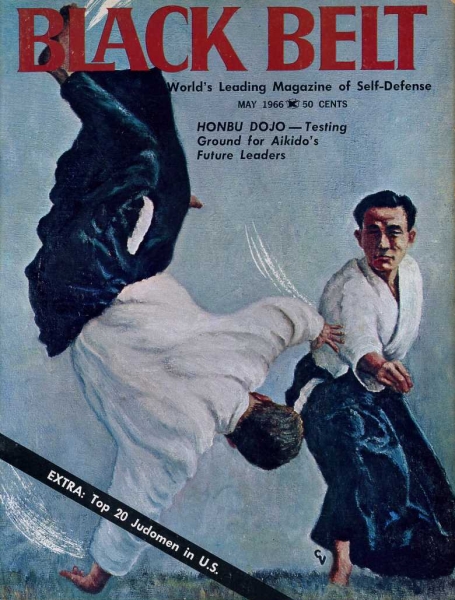
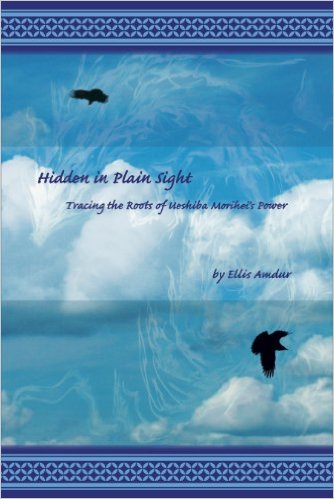


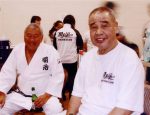

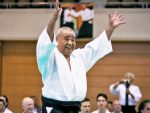
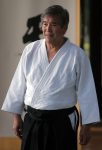
WOW!! This excellent article is well researched and hits on every cylinder. I wonder how mainstream aikido would/will respond to this if they were ever to read and contemplate this material and it’s implications. As a sidebar… The German philosopher, Immanuel Kant, was floored by a treatise written by David Hume. It forced him to re-evaluate his philosophical understandings (“Hume awakened me from my dogmatic slumber’) and he responded by writing his brilliant CRITUQUE OF PURE REASON. How many aikidokas will allow themselves to be awakened? Thanks again to all for their contributions.
Thanks Mark, hopefully it will help motivate folks to consider these very important issues!
Best,
Chris
The unknown person in the O Sensei photo is Edward Yamaguchi. He was a math teacher in San Mateo, CA and was in Japan on a sabatical. He was a fine Aikidoist and also a good judoka. Most importantly he was a fine gentleman.
Bob Noha
Thanks Bob, I updated the caption!
Best,
Chris
I’m curious about the demonstration in Manchuria with Ohba. I’ve never heard about it before. Are there any more details to it? It seems like even though O-Sensei was forced to improvise, he handled himself well. Is that the case? Great article. Thanks.
It’s also mentioned here, by Shigenobu Okumura:
https://www.aikidosangenkai.org/blog/interview-aikido-shihan-shigenobu-okumura-part-1/
And here’s Ohba’s side of the story, in his own words:
“Since the Emperor of Manchuria was in an exalted position at that time like the Emperor of Japan I thought I should not take ukemi for Ueshiba in the way I usually did. If Ueshiba Sensei were a true master he could freeland handle a true punch, thrust or grab. Therefore, I decided to attack him seriously. When we stood on the platform I saw many martial arts masters present in the large dojo of the Shimbuden. When I glanced at Ueshiba Sensei, his beard was sticking out towards me, his hair was standing on end and his eyes were glittering. I thought to myself that he was indeed a true master. Then I concentrated on taking ukemi for him thinking how different it was to face a master. After the demonstration we bowed and sat in the corner of the dojo and were supposed to walk over to the seats where the masters were sitting. However, I heard someone thunder, ‘You idiot!’ Ueshiba Sensei was short-tempered. He couldn’t wait until we returned to our seats. He shouted at me in that way in front of everyone. Until then I thought he was a wonderful and truly great master, but his shout made my spirit pop like a bubble. We sat down. Ueshiba Sensei didn’t even smile. He was in a bad mood. So I felt tiny. Who do you think showed up then? It was Hideo Sonobe who was said to be without peer in Japan or anywhere in the use of the Naginata. She came all the way up to where the masters were sitting while Iai and Naginata kata were being demonstrated one after another. She said, ‘Mr. Ueshiba I have never seen more wonderful techniques than what you showed today. They were fantastic!’ Ueshiba Sensei, who had been in a bad mood, asked her what part she liked. He asked me to find a place where they could talk and we all went down to the basement of the Shimbuden and they discussed the theory of martial arts for two hours. While I was listening to their discussion Ueshiba Sensei asked her what she liked and she replied that she liked the ‘connections’ (tsunagari) between techniques. However, I didn’t understand these connections. I understood that the Dai Nihon Butokukai [Kyoto-based organization which governed Japanese martial arts] then was having a hard time trying to decide who they should choose as the best swordsman of that year and had asked Sonobe Sensei for her opinion. When I heard Sonobe Sensei tell Ueshiba Sensei that she had never seen such wonderful techniques even though she had seem him demonstrate often, I decided to learn Naginata in order to search for these ‘connections.’”
Best,
Chris
Thanks, Chris! I haven’t been home since I’ve started Aikido but my family is still in Mililani. I hope to visit this year and maybe, drop by for some training.
Wonderful, come by if you get the chance!
Best,
Chris
Many thanks for this amazing article!
I wonder about this section though:
Shioda Sensei, like many other former students of O-Sensei, felt that O-Sensei’s teaching was unsystematic, and he therefore devised his own set of basic exercises that were intended to make the art easier for the average person to learn. These basic exercises (hiriki no yosei and shumatsu dosa, for instance) are not found in other dojos.
Is this to say that Shioda Gozo made up these exercises? Hirihi no Yosei (Morotedori Kokyuho) and Shumatsu Dosa for example are practiced in Iwama aikido and also both present in the 1938 Budo training manual.
Hi Michal,
Yes, variants of those exercises appear in the 1938 manual and in some other dojo (not just Iwama), but Gozo Shioda did systemize them into the six basic kihon practiced in the Yoshinkan and made them the center of his curriculum.
Best,
Chris
Thanks for the explanation Chris!
I am not sure if its right to take Morihei out of “modern” Aikido. In John Stevens book its written that Morihei said that he gave the techniques of Aikido as a religion for those who cant believe in Kami an Omoto kyu.
Also if he didnt teached much in Tokyo he did and he was aware what his son and others were creating .
He wasnt an idiot who didnt saw what happened in the Aikikai.
Maybe he really wasnt interested in it that the masses learn real martial Aiki.
On the other hand Saito was doing quite a different Aikido what was more martial, and he was all the time in Iwama. But he also didn gain the abilitys of Morihei.
Man truth is really hard to get here.
John Stevens statement is his opinion – that’s neither good nor bad, but it’s important to remember that it’s just his opinion.
Of course Morihei Ueshiba was aware of what was happening, but he was also retired and out of the loop – by the 1960’s his son Kisshomaru had been running things for some 20 years already, that’s how far away he was from the time during which he was running things. And of course, his complaining about what was happening in Tokyo is well documented.
Best,
Chris
Hello
Saito has been, as you know, a student of O’Sensei for at least 24 years. He must have received a little more than the other Uchi deschi seems to me. When do you think ?
I think that it’s not as simple as time in, otherwise Kisshomaru Ueshiba might have been the one closest to Morihei Ueshiba by far.
Spending 10 years with Einstein doesn’t make me Einstein, no matter what. Conversely, many people like Einstein are poor teachers, and many less capable people often turn out to be much better teachers.
I’m not saying the Morihiro Saito was stupid, but there are many factors in play – what one learned, what one was capable of learning, what one was capable of doing, what one was capable of transmitting, and so forth. My personal experience with him was that he was quite skilled, but struggled to transmit those skills to his students (that’s not unusual, it’s very common for great athletes to be mediocre coaches).
His primary concern, to my mind, was to preserve the precise form of what he saw Morihei Ueshiba do as closely as he could, and in that, I think that what he did was of great importance.
Best,
Chris
How long have you been studying with Saito ?
What’s your point, and why does that matter? An argument should stand and fall on its own merits, IMO, not on an appeal to authority or association.
Best,
Chris
The time spent with a teacher is important to me.
HI Sylvain,
So if I spent ten years with Einstein and you spent five – that would make me a better physicist? I’m sorry, but that’s really a nonsensical argument in just about any context that I can imagine. If you disagree with a particular opinion (you haven’t here, except for a vary vague and unsupported statement about Morihiro Saito) than make your argument, that’s fine, but an argument is valid or invalid based upon its own merits, whether made by a 5th kyu or a 5th dan.
Best,
Chris